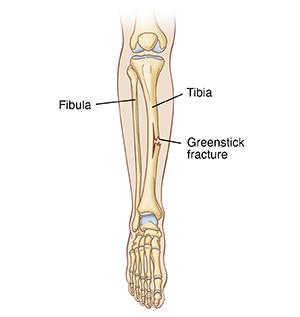Greenstick Fracture of the Leg (Child)
Your child has a broken bone or fracture in the leg called a greenstick fracture. This is when one side of the bone cracks, and the other side bends without any break. This is a very common fracture in children because their bones are softer. It's also called an incomplete fracture.
If a greenstick fracture causes the bone to be angled, the bone may need to be straightened before applying a splint or cast. This is called reducing the fracture. A splint or cast will be needed for at least 3 weeks.

Home care
Medicines
-
The provider may prescribe medicines for pain and swelling. Or your child may use over-the-counter medicine as directed by the provider. Follow the provider’s instructions when giving these medicines to your child.
-
Always talk with your child's provider before giving these medicines if your child has chronic liver or kidney disease, or has ever had a stomach ulcer or gastrointestinal bleeding.
-
Don’t use ibuprofen in children younger than 6 months old.
-
Don’t give your child aspirin. Taking aspirin can put your child at risk for Reye syndrome. This is a rare but very serious disorder that most often affects the brain and the liver.
General care
-
Your child will be given a splint, cast, or special boot to keep the injured area from moving. Your child should not put weight on a splint, as it will break. Follow the provider’s advice about when your child can begin to bear weight on a cast or boot.
-
Keep your child’s leg raised above heart level when sitting or lying down. This is very important during the first 48 hours.
-
Keep the cast, splint, or boot dry at all times. When bathing, protect the cast, splint, or boot with 2 large plastic bags. Place 1 bag outside of the other. Tape each bag with duct tape at the top end or use rubber bands. Younger children may be hurt when removing duct tape. For younger children, put a rubber band around each bag at the top end. Water can still leak in. So it's best to keep the cast, splint, or boot away from water. If a boot or fiberglass cast or splint gets wet, dry it with a hairdryer on a cool setting.
-
Apply an ice pack over the injured area for 20 minutes. Do this every 1 to 2 hours on the first day. Keep using ice packs 3 to 4 times a day for the next 2 days. Then use as needed to ease pain and swelling.
-
To make an ice pack, put ice cubes in a plastic bag that seals at the top. Wrap the bag in a clean, thin towel or cloth. Never put ice or an ice pack directly on the skin. The ice pack can be put right on the cast or splint. If your child has a boot, open it to apply the ice pack, unless told otherwise by the provider. As the ice melts, be careful that the cast, splint, or boot doesn’t get wet.
Follow-up care
Follow up with your child’s healthcare provider in 1 week, or as advised. This is to be sure the bone is healing correctly. If your child was given a splint, it may be changed to a cast at the follow-up visit. There is a chance that a greenstick fracture will move out of place again during the first week, before the ends begin to seal together. So it's important that you follow up as directed for another X-ray.
If X-rays were taken, you'll be told of any new findings that may affect your child’s care.
Special note to parents
Healthcare providers are trained to recognize injuries like this one in young children as a sign of possible abuse. They may ask questions about how your child was injured. Healthcare providers are required by law to ask you these questions. This is done for the child's protection. Please try to be patient and don't get upset.
When to get medical advice
Call your child's healthcare provider right away if any of the following occur:
-
The cast or splint becomes loose
-
The cast or splint has a bad smell
-
The cast or splint has cracks or breaks
-
The plaster cast or splint becomes wet or soft
-
The fiberglass cast or splint stays wet for more than 24 hours
-
There is increased tightness, soreness, or pain under the cast or splint
-
The toes become swollen, cold, blue, numb, or tingly
Online Medical Reviewer:
L Renee Watson MSN RN
Online Medical Reviewer:
Raymond Turley Jr PA-C
Online Medical Reviewer:
Thomas N Joseph MD
Date Last Reviewed:
1/1/2022
© 2000-2024 The StayWell Company, LLC. All rights reserved. This information is not intended as a substitute for professional medical care. Always follow your healthcare professional's instructions.